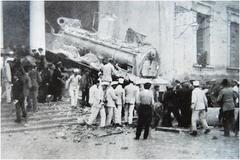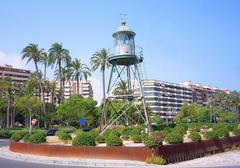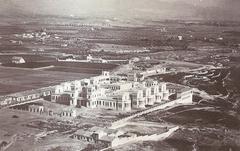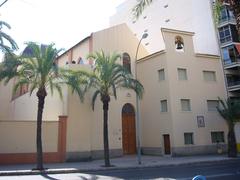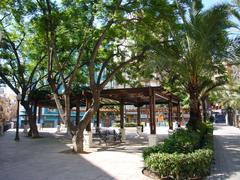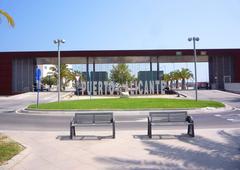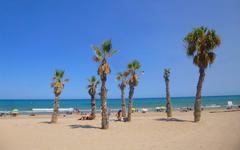Torre Sarrió Alicante: Visiting Hours, Tickets, and Travel Guide
Date: 14/06/2025
Introduction
Torre Sarrió is a striking emblem of Alicante’s layered history, standing as both a relic of the region’s defensive architecture and a testament to its enduring agricultural and community traditions. Built in 1594, the tower was part of the Torres de la Huerta network—an array of fortifications designed to protect the fertile huerta from Berber corsair attacks. Today, following comprehensive restoration, Torre Sarrió invites visitors to experience Alicante’s past through its preserved architecture, interpretive displays, and vibrant cultural programming. This guide provides everything you need to know for your visit, from historical context and architectural features to practical tips, nearby attractions, and future prospects for the site (castillosricsol.es; alicante.es; lavanguardia.com).
Table of Contents
- Discover Torre Sarrió: Alicante’s Iconic Defensive Tower
- Historical Context: Origins, Construction, and the Corsair Threat
- Evolution and Restoration: From Defense to Culture
- Architectural Features and Interpretive Highlights
- Visitor Information: Hours, Tickets, and Accessibility
- Integration into Cultural Routes & Nearby Attractions
- Future Prospects: Musealization and Smart Tourism
- Frequently Asked Questions (FAQ)
- Visual & Media Resources
- Conclusion and Visitor Tips
- Sources
Discover Torre Sarrió: Alicante’s Iconic Defensive Tower
Set amidst Alicante’s historic huerta, Torre Sarrió offers a unique window into the intersection of rural life, military defense, and urban transformation. Constructed in 1594, its robust masonry and square-plan design typify the fortifications built to shield the region from piracy. Beyond its strategic function, Torre Sarrió evolved into a center of rural community life, a role it continues to play today as a restored heritage and cultural site.
Historical Context: Origins, Construction, and the Corsair Threat
Origins and Construction
Commissioned by Pere Llopis, a prominent landowner, Torre Sarrió’s inscription “PERE LLOPIS 1594” affirms its late 16th-century origins. Crafted from small masonry blocks with solid ashlar corners, the tower comprises three stories above a ground floor, joined to a large house that was historically used for storage and residence (castillosricsol.es; alicante.es).
The Corsair Threat and Defensive Network
The threat of Berber corsairs loomed large over the Mediterranean coasts of Spain from the late 15th to the 17th centuries. In response, local elites—often with municipal or royal backing—financed a defensive network of over thirty towers, the Torres de la Huerta. Positioned for visual contact with each other and the Castillo de Santa Bárbara, these towers provided refuge and early warning to the community. Signal fires and cannon shots would alert the militia and rural workers to seek shelter (elespanol.com; alicante.es).
Evolution and Restoration: From Defense to Culture
Transformation Through the Centuries
- 16th–17th Centuries: Originally a defensive stronghold and refuge.
- 18th–19th Centuries: With the decline of piracy, the tower shifted to agricultural and residential uses, and some towers fell into neglect (lavanguardia.com).
- 20th Century: Urban expansion threatened many towers, but Torre Sarrió survived, albeit with some non-historic uses (castillosricsol.es).
- 21st Century Restoration: Major restoration (2010–2021) included removing non-original elements, structural consolidation, restoration of the cistern and wine cellar, and preparing the site for musealization (alicante.es; Informacion.es).
Modern Significance and Musealization
Torre Sarrió is now municipally owned, designated as a Bien de Interés Cultural (BIC), and is set to become the official Center for Interpretation of the Torres de la Huerta by 2026. The musealization project, led by the Ayuntamiento de Alicante and Fundación CV MARQ, will feature exhibitions on the towers’ history, architecture, and social impact, with a special focus on unique artifacts like the ship graffiti etched into the tower’s wall (lavanguardia.com).
Architectural Features and Interpretive Highlights
- Square Plan and Masonry: Measuring approximately 6 meters per side, the tower’s thick walls and minimal windows reveal its defensive purpose.
- Annexed Historic House: Integrated storage and residential spaces illustrate the blend of domestic and defensive functions.
- Historic Cistern and Wine Cellar: Restored features highlight the site’s agricultural heritage.
- Graffiti and Artifacts: The rare ship drawing and other markings provide insight into the daily life and anxieties of its occupants (lavanguardia.com).
Visitor Information: Hours, Tickets, and Accessibility
Location: Partida de La Condomina, Alicante, approximately 7 km from the city center.
How to Get There:
- By car (parking available nearby), public bus, or bicycle via the Torres de la Huerta heritage route (The Costa Blanca Guide; View from La Vila).
Visiting Hours:
- Typically Tuesday to Sunday, 10:00 AM to 6:00 PM. Closed Mondays and public holidays. Confirm hours before your visit as they may vary for special events or restoration (alicante.es).
Tickets:
- Admission is currently free pending the official opening of the interpretation center in 2026. Guided tours and special activities may have a nominal fee (alicante.es).
Accessibility:
- Ramps and paved paths provide partial access for visitors with reduced mobility, though some interior sections may remain limited due to the historic structure (View from La Vila).
Amenities:
- Reception area with brochures, rest areas, interpretive signage, and restrooms available nearby.
Guided Tours and Special Events:
- Regular guided tours (often on weekends), themed wine tastings, educational workshops, and cultural events are scheduled throughout the year.
Integration into Cultural Routes & Nearby Attractions
Cultural Routes:
- Torre Sarrió is part of a 12-kilometer circular heritage route connecting 19 surviving Torres de la Huerta, ideal for walking or cycling (elespanol.com).
Nearby Attractions:
- Santa Bárbara Castle: Panoramic city views and exhibitions (PlanetWare)
- Esplanade of Spain: Iconic palm-lined promenade
- Central Market: Local produce and foods
- Postiguet Beach: Relaxation after sightseeing
- MARQ Archaeological Museum: Alicante’s leading cultural institution
Cafés, restaurants, and shops in the vicinity provide local cuisine and souvenirs (PlanetWare).
Future Prospects: Musealization and Smart Tourism
- Interpretation Center: Opening in 2026, with €200,000 allocated for its transformation into a cultural hub (alicante.es; Informacion.es).
- Digital Innovation: Planned AR/VR experiences, interactive digital guides, and virtual tours to improve accessibility and engagement (RevFine).
- Sustainability: Controlled visitor numbers, eco-friendly practices, and community involvement in heritage preservation (LinkAlicante).
- Cultural Programming: Workshops, festivals, and educational initiatives in partnership with MARQ and local schools (Agenda Cultural Diputación Alicante).
Frequently Asked Questions (FAQ)
Q: What are Torre Sarrió’s visiting hours?
A: Typically Tuesday to Sunday, 10:00 AM to 6:00 PM. Check the official site for updates.
Q: How can I purchase tickets?
A: Admission is currently free; guided tour tickets may be available on-site or online.
Q: Is Torre Sarrió accessible?
A: Ramps and paved paths provide partial accessibility.
Q: Are guided tours available?
A: Yes, on weekends and by appointment for groups.
Q: What other attractions are nearby?
A: Santa Bárbara Castle, Esplanade of Spain, Central Market, Postiguet Beach, and other Torres de la Huerta.
Visual & Media Resources
- Images: High-resolution photos of Torre Sarrió’s exterior, interior, wine cellar, and ship graffiti with optimized alt tags (e.g., “Torre Sarrió Alicante historical site”).
- Maps: Interactive cultural route maps connecting Torre Sarrió to other heritage sites.
- Virtual Tours: Available via the official tourism portal or the Audiala app.
Conclusion and Visitor Tips
Torre Sarrió is a living monument, bridging Alicante’s dramatic history with its vibrant present. Its meticulous restoration, integration into cultural routes, and pending transformation into a center for interpretation ensure its relevance for generations to come. Plan your visit during the spring or autumn for the best weather, bring comfortable footwear and sun protection, and consider joining a guided tour for deeper insight.
Plan Your Visit:
- Download the Audiala app for audio guides and interactive maps.
- Visit the official Alicante tourism portal for the latest updates.
Sources
- castillosricsol.es
- alicante.es
- lavanguardia.com
- elespanol.com
- View from La Vila
- Informacion.es
- The Costa Blanca Guide
- Plinthus
- LinkAlicante
- PlanetWare
- RevFine
- Agenda Cultural Diputación Alicante
